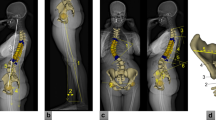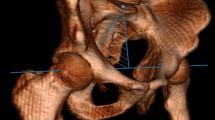Abstract
Background
Vertebral anterior overgrowth has been suggested as part of the etio-pathogenesis of adolescent idiopathic scoliosis (AIS). However, the link between 3D spinopelvic alignment and the vertebral anteroposterior height asymmetry in different scoliotic curves types and whether it deviates from the non-scoliotic controls, has not been studied.
Purpose
We aimed to retrospectively describe the link between the anteroposterior vertebral height differences (ΔAPVH) measured in the true sagittal plane of each vertebra and the spinopelvic parameters in three anatomical planes.
Methods
30 AIS cases with primary thoracic curves, 28 with thoracolumbar/lumbar curves, and 20 non-scoliotic controls were included. All subjects had 3D reconstruction of the spine, generated from low-dose upright stereoradiography images. Pelvic incidence (PI), thoracic and lumbar coronal and sagittal curve measurements, and vertebral axial rotation were measured. The association between the spinopelvic parameters and ΔAPVH were compared between the two AIS and control groups.
Results
ΔAPVH at the apex of the curve was significantly different between the two AIS groups, as well as between both AIS groups and the controls and was related to the vertebral apical rotation (p < 0.05). Kyphosis and lordosis measurements were significantly related to the sum of the ΔAPVH in thoracic and lumbar regions respectively in AIS group but not in non-scoliotic controls (p < 0.05).
Conclusions
The ΔAPVH depended on the scoliotic curve type and was significantly different from the controls only at the apical levels. Morphological changes in the scoliotic vertebrae, measured as anterior-posterior differences in the vertebral height, are related to the sagittal spinal profile suggesting the morphology of the vertebra contributes to the sagittal curvatures of the spine in AIS; nonetheless, such relationship between the vertebral morphology and the sagittal profile was not evident in non-scoliotic controls.
Similar content being viewed by others
References
Stokes IA, Bigalow LC, Moreland MS. Three-dimensional spinal curvature in idiopathic scoliosis. J Orthop Res 1987;5(1):102–13.
Upasani VV, Tis J, Bastrom T, et al. Analysis of sagittal alignment in thoracic and thoracolumbar curves in adolescent idiopathic scoliosis: how do these two curve types differ? Spine (Phila Pa 1976) 2007;32(12): 1355–9.
Cheng JC, Castelein RM, Chu WC, et al. Adolescent idiopathic scoliosis. Nature Primer 2015;1:1–20.
Masharawi Y, Salame K, Mirovsky Y, et al. Vertebral body shape variation in the thoracic and lumbar spine: characterization of its asymmetry and wedging. Clin Anat 2008;21(1):46–54.
Nault ML, Mac-Thiong JM, Roy-Beaudry M, et al. Three-dimensional spinal morphology can differentiate between progressive and nonprogressive patients with adolescent idiopathic scoliosis at the initial presentation: a prospective study. Spine (Phila Pa 1976) 2014;39(10):E601–6.
Brink RC, Colo D, Schlosser TPC, et al. Upright, prone, and supine spinal morphology and alignment in adolescent idiopathic scoliosis. Scoliosis Spinal Disord 2017; 12:6.
Masharawi Y, Salame K. Shape variation of the neural arch in the thoracic and lumbar spine: characterization and relationship with the vertebral body shape. Clin Anat 2011;24(7):858–67.
Schlosser TP, van Stralen M, Brink RC, et al. Three-dimensional characterization of torsion and asymmetry of the intervertebral discs versus vertebral bodies in adolescent idiopathic scoliosis. Spine (Phila Pa 1976) 2014;39(19):E1159–66.
Deacon P, Flood BM, Dickson RA. Idiopathic scoliosis in three dimensions. A radiographic and morphometric analysis. J Bone Joint Surg Br 1984;66(4):509–12.
Deacon P, Dickson RA. Three dimensional analysis of right thoracic idiopathic scoliosis. Spine (Phila Pa 1976) 1985;10(3):292.
Newell N, Grant CA, Keenan BE, Izatt MT, Pearcy MJ, Adam CJ. Quantifying Progressive Anterior Overgrowth in the Thoracic Vertebrae of Adolescent Idiopathic Scoliosis Patients: A Sequential Magnetic Resonance Imaging Study. Spine (Phila Pa 1976) 2016;41 :E382–7.
Roaf R. Vertebral growth and its mechanical control. J Bone Joint Surg Br 1960;42-B:40–59.
Brink RC, Schlosser TPC, Colo D, et al. Anterior Spinal Overgrowth Is the Result of the Scoliotic Mechanism and Is Located in the Disc. Spine (Phila Pa 1976) 2017;42(11):818–22.
Stokes IA, Burwell RG, Dangerfield PH. Ibse. Biomechanical spinal growth modulation and progressive adolescent scoliosis—a test of the ‘vicious cycle’ pathogenetic hypothesis: summary of an electronic focus group debate of the IBSE. Scoliosis 2006; 1:16.
Pasha S, Cahill PJ, Dormans JP, Flynn JM. Characterizing the differences between the 2D and 3D measurements of spine in adolescent idiopathic scoliosis. Eur Spine J 2016;25(10):3137–45.
Illes T, Tunyogi-Csapo M, Somoskeoy S. Breakthrough in three-dimensional scoliosis diagnosis: significance of horizontal plane view and vertebra vectors. Eur Spine J 2011;20(1):135–43.
Pasha S, Schlosser T, Zhu X, Mellor X, Castelein R, Flynn J. Application of Low-dose Stereoradiography in In Vivo Vertebral Morphologic Measurements: Comparison With Computed Tomography. J Pediatr Orthop 2017.
Core Team R. R: A Language and Environment for Statistical Computing [computer program]. Vienna, Austria: R Foundation for statistical Computing; 2017.
Guo X, Chau WW, Chan YL, Cheng JC. Relative anterior spinal overgrowth in adolescent idiopathic scoliosis. Results of disproportionate endochondral-membranous bone growth. J Bone Joint Surg Br 2003;85(7): 1026–31.
Liljenqvist UR, Link TM, Halm HF. Morphometric analysis of thoracic and lumbar vertebrae in idiopathic scoliosis. Spine (Phila Pa 1976) 2000;25(10): 1247–53.
Liljenqvist U, Hackenberg L. Morphometric analysis of thoracic and lumbar vertebrae in idiopathic scoliosis. Stud Health Technol Inform 2002;88:382–6.
Panjabi M, Chang D, Dvorak J. An analysis of errors in kinematic parameters associated with in vivo functional radiographs. Spine (Phila Pa 1976) 1992;17(2):200–5.
Scholten PJ, Veldhuizen AG. The influence of spine geometry on the coupling between lateral bending and axial rotation. Eng Med 1985;14(4):167–71.
Blondel B, Lafage V, Schwab F, Farcy JP, Bollini G, Jouve JL. Reciprocal sagittal alignment changes after posterior fusion in the setting of adolescent idiopathic scoliosis. Eur Spine J 2012;21(10): 1964–71.
Mac-Thiong JM, Labelle H, Charlebois M, Huot MP, de Guise JA. Sagittal plane analysis of the spine and pelvis in adolescent idiopathic scoliosis according to the coronal curve type. Spine (Phila Pa 1976) 2003;28(13): 1404–9.
Pasha S, Baldwin K. Are we simplifying balance evaluation in adolescent idiopathic scoliosis? Clin Biomech 2018;51:91–8.
Pasha S, Baldwin K. Preoperative sagittal spinal profile of adolescent idiopathic scoliosis Lenke types and non-scoliotic adolescents: a systematic review and meta-analysis. Spine 2018. https://doi.org/10.1097/BRS.0000000000002748 [Epub ahead of print].
Pasha S, Ilharreborde B, Baldwin K. Sagittal spinopelvic alignment after posterior spinal fusion in adolescent idiopathic scoliosis: a systematic review and meta-analysis. Spine 2018. https://doi.org/10.1097/BRS.0000000000002736 [Epub ahead of print].
Pasha S, Flynn JM, Sankar WN. Outcomes of selective thoracic fusion for Lenke 1 adolescent idiopathic scoliosis: predictors of success from the sagittal plane. Eur Spine 2018. https://doi.org/10.1007/s00586-018-5553-9 [Epub ahead of print].
Author information
Authors and Affiliations
Corresponding author
Additional information
Conflicts of Interest and Source of Funding: The authors report no conflicts of interest relevant to this submission. This study received no funding and was approved by the Institutional Review Board.
The device(s)/drug(s) is/are FDA-approved or approved by corresponding national agency for this indication.
Rights and permissions
About this article
Cite this article
Pasha, S., Sankar, W.N. & Castelein, R.M. The Link Between the 3D Spino-pelvic Alignment and Vertebral Body morphology in Adolescent Idiopathic Scoliosis. Spine Deform 7, 53–59 (2019). https://doi.org/10.1016/j.jspd.2018.05.016
Received:
Revised:
Accepted:
Published:
Issue Date:
DOI: https://doi.org/10.1016/j.jspd.2018.05.016




